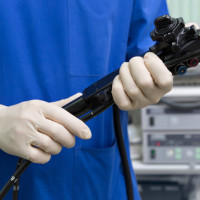“Superbug” Lawsuits Continue Against Medical Device Company Olympus America

A litany of complaints has been filed against medical device manufacturer Olympus America in the wake of the deadly UCLA “superbug” outbreak that has left two people dead and many more potentially exposed to the bacteria. The numerous complaints commonly allege that Olympus America failed to provide the necessary cleaning instructions that would have allowed hospital staff to adequately sterilize the specialized endoscopes it sells.
The bacteria in question, carbapenem-resistant Enterobacteriaceae (more frequently referred to as CRE), is highly resistant to antibiotics, and as a result, it can kill up to 50% of infected patients. Of the seven patients known to have been infected during the outbreak, two have died. Officials estimate that over 180 other patients may have potentially been exposed to the bacteria.
Improper Sterilization Alleged
The specialized Q180V model endoscopes (also known as duodenoscopes) were allegedly redesigned in 2014, yet no additional cleaning instructions were provided following the update, according to the complaints. The UCLA hospital where the outbreak took place claims in its defense that it “sterilized the scopes according to the standards stipulated by the manufacturer.” While it appears that none of the lawsuits filed thus far have named the hospital as a defendant, the UCLA Ronald Reagan Medical Center has refused to comment on the pending litigation.
Instead, the plaintiffs have launched a variety of accusations at the manufacturer, claiming that Olympus America engaged in negligence, products liability, and even fraud. “The manufacturer must ensure that the validated reprocessing protocol is disseminated to medical facilities and professionals,” says one of the complaints. It further concludes, “Olympus failed to take these critical steps with the redesigned Q180V scope.”
How Great Is the Danger?
Says infection control expert Marc-Oliver Wright, “If this can happen at UCLA this can happen everywhere.” The endoscopic devices in question are used in more than 500,000 procedures each year across the U.S., and are primarily used to drain fluids, inject contrast dyes, or insert other medical instruments to obtain biopsies or treat abnormalities. The light, flexible tubes are notoriously difficult to clean as a result of their design.
According to guidelines published by the U.S. Food and Drug Administration, the complex design of the endoscopes had the potential to impede the ability of hospital staff to “clean, disinfect and sterilize [the] reusable devices.” A scant two days after the UCLA outbreak came to light, the FDA issued a statement that “effective cleaning of all areas of the duodenoscope may not be possible.” Accordingly, the FDA has come under heavy fire for failing to more aggressively regulate the devices prior to the superbug outbreak.
UCLA Medical’s own director, Dr. Zachary Rubin, has been critical of the FDA’s guidelines and Olympus America’s recommendations. “The fact that we’ve identified this infection in a couple of different hospitals now suggests that the routine process we were using was just not quite adequate even though at the time they were FDA approved,” said Rubin.
Medical device cases are complicated, and if you or anyone you know has been exposed to infection at a hospital, you should only speak to expert attorneys who specialize this field. Here at Magaña, Cathcart & McCarthy, we have the expertise and knowledge that you need for your case to succeed. If you think you may have been injured, call us immediately at 310-553-6630.


 Close Menu
Close Menu